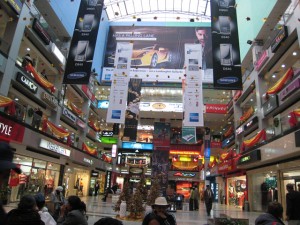 By: Ravi Sinha
By: Ravi Sinha
When Victor Gruen, a Vienna architect and the father of the modern shopping mall designed the first modern shopping mall of America, called Southdale in early 1940s, he received considerable critical praise by the media and marketers in the New York and in New Jersey. Gruen’s unique design feature and the idea of putting the whole shopping complex under one roof might have been a visionary concept for a developer and created significant positive changes for retailers, but there was apprehension all around. Critics and shoppers raved about the atmosphere, convenience and design of the mall. Even more challenging task for Gruen was to bring about a metamorphosis in the suburban shopping center, which till then was which till then was in open with stores connected by outdoor passageways.
Today virtually every shopping center in America is at minimum a fully enclosed introverted, multi-tiered, double-anchor-tenant complex with a garden court under a skylight. Gruen’s retailing model eventually became the paradigm of retail property development across the world. In India the early 1990s experienced the shopping malls expanding their footprint with well designed, built on international formats of retailing and integrated with entertainment and restaurants to provide a complete family experience. Shopping centers till then were designed and built to house several shops in a single facility. These Centers also known as Shopping Arcades offered only rows of shops, most of which were small stores, with no avenues for recreation and entertainment.
The new format malls were designed professionally using a lot of international experience and combine shopping with brand building, recreation, food & entertainment. The cities that witnessed the first rush of malls are Delhi, Noida, Gurgaon, Chandigarh, Mumbai, Pune, Bangalore, Ahmedabad, Chennai, Kochi, Hyderabad and Kolkata. However, these shopping paradise remained a delicate commercial proposition for most of the developers. The business sense till then seem to suggest that the new format cost too much to build and too long for a developer to recover his costs. And hence the exotic malls were planned only in the metros and tier-II cities.
The growth drivers of the Indian market had their own plans that turned the dismal economics of the mall upside down. Within a span of less than a decade it started moving down the ladder. In a spate of booming and consumption economy tier-II and III cities suddenly were seen to be a major buzzword for the retailing industry. Mall developers across the country took cognizance of this and were increasingly eyeing cities like Bhopal, Kanpur, Coimbatore, Surat, Lucknow, Vijaywada, Bhopal, Indore, Vadodara, Dehradun, Nasik, Bhubhaneswar, Varanasi and Ludhiana for growth.
The author is the Managing Editor of Track2Realty





